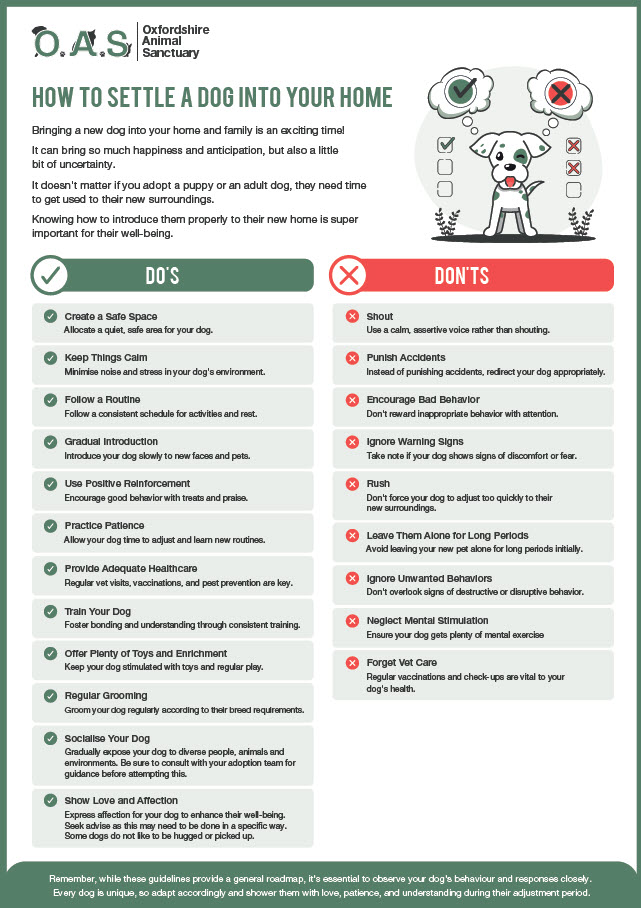Bringing a new dog into your home can be an exhilarating experience filled with joy, anticipation, and inevitably, a certain degree of uncertainty.
Whether you’ve adopted a puppy or an adult dog, they require time to adjust to their new environment. Understanding how to properly introduce them to their new home is paramount for their health, happiness, and general well-being.
Here are some essential do’s and don’ts to follow when settling a dog into your home and a handy checklist for you to download!
Do’s
Create a Safe Space
Designate a safe, quiet space in your home for your new canine friend, such as a particular room or a crate, if crate training. This will provide a comforting sanctuary where they can retreat if they feel overwhelmed. This can include being away from other humans too – particularly children.
Keep Things Calm
Try to minimise stress by keeping the environment peaceful and quiet. This includes keeping other pets away initially, reducing loud noises, and avoiding large gatherings.
Follow a Routine
Dogs thrive on routine. Implement a consistent schedule for feeding, walking, playtime, and rest to help them adapt more quickly.
Gradual Introduction
Gradually introduce your dog to other family members and pets, always monitoring their reactions. Remember that every dog is different; some may take longer to adjust than others.
Use Positive Reinforcement
Positive reinforcement, like treats and praise, can go a long way in helping a dog adjust to its new surroundings and learn desired behaviours.
Practice Patience
Dogs may take time to adjust to their new surroundings and learn your rules and routines. Don’t expect them to understand everything instantly.
Provide Adequate Healthcare
Make sure to provide regular veterinary check-ups and keep up with vaccinations, flea, and tick prevention.
Train Your Dog
Training your dog helps establish a strong bond and helps them understand what is expected of them. This can include obedience training, house training, and socialization.
Offer Plenty of Toys and Enrichment
Toys, puzzles, and regular playtime can help keep your dog entertained and mentally stimulated.
Regular Grooming
Depending on the breed, your dog may require regular grooming. This can include brushing, bathing, and nail trims.
Don’ts
It’s crucial to understand how to properly behave around dogs, especially when bringing a new dog into your home.
Some “Don’ts” for dog owners include:
Don’t Shout
Dogs can be easily scared or confused by loud noises and shouting. Always use a calm, assertive voice when communicating with your dog.
Don’t Punish Accidents
If your dog has an accident in the house, don’t yell or physically punish them. Instead, clean it up and redirect them to the appropriate place (like outside or on puppy pads) next time.
Don’t Encourage Bad Behaviour
If your dog is behaving badly, don’t reinforce the behaviour by giving them attention. Instead, redirect them to more appropriate behaviour.
Don’t Ignore Warning Signs
If your dog is showing signs of stress, discomfort, or fear, don’t ignore them. These signs could be a cue that your dog is uncomfortable or that something is wrong.
Don’t Rush
It’s important to not force your dog to adapt too quickly. They’ve been introduced to an entirely new environment, and pushing them can lead to stress, anxiety, and potentially unwanted behaviours.
Don’t Leave Them Alone for Long Periods
In the early days, try not to leave your new pet alone for extended periods. This could increase their anxiety levels and potentially lead to destructive behaviours.
Don’t Ignore Unwanted Behaviours
If your dog exhibits unwanted behaviours like chewing furniture or barking excessively, don’t overlook these signs. Instead, address these behaviours early on with appropriate training methods.
Don’t Neglect Mental Stimulation
While it’s important to keep things calm, your new dog still needs mental stimulation. Vary the types of games and keep them engaged. Our dog team often tell adopters not to exercise for a few days (but every dog is different!) or even longer, to enable adopters to focus on bonding with the dog before going outdoors. This can often lead to over-excitement and to make matters more stressful, the dog doesn’t yet trust them enough to look to them for safety or cues.
Don’t Forget Vet Care
Ensure that your new pet is up-to-date with vaccinations and regular health check-ups. A healthy dog is a happy dog.
Remember, every dog is an individual, and the amount of time it takes for them to adjust to a new home can vary significantly. While these guidelines provide a general roadmap, always pay close attention to your dog’s behaviour and responses.
Most importantly, provide them with abundant love, patience, and understanding as they navigate their new surroundings.
Welcoming a dog into your home is a meaningful and life-changing commitment that, when done with thoughtful consideration, can result in a rewarding bond of mutual respect, love, and companionship.


